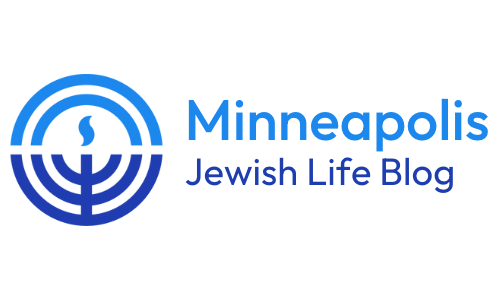Caring Connections finds success with virtual events (plus 5 tips for a virtual seder!)
Comments from Caring Connections participants after a virtual event
Jewish Family and Children’s Service of Minneapolis is a partner organization of Minneapolis Jewish Federation.
“Next year in person!” we all said hopefully at the end of last year’s Zoom Seder.
But a year has passed and, odds are, you’re planning yet another virtual Passover Seder. For many of us, the appeal and novelty of virtual events has long since worn off. Stacey Spencer, Jewish Inclusion Program Manager at Jewish Family and Children’s Service of Minneapolis (JFCS), has had a different experience. The inclusion program Caring Connections has built a robust calendar of virtual events that are incredibly well attended by adults with disabilities—and it all started with a Seder.
Isolation during the pandemic is of particular concern for adults with disabilities, and Stacey says she and her team are doing whatever they can to help people feel less isolated. Since that first Seder, Caring Connections has hosted karaoke night, private concerts and magic shows, and a karaoke Chanukah party. Stacey has also conducted 120 visits—both virtual and in-person with precautions—with Caring Connections participants.
“Before COVID, we were doing 6-8 events per year,” says Stacey. “Now we do two per month!”
Now that the Caring Connections team has a year’s worth of experience making virtual events meaningful, and as many of us prepare to host a virtual Seder, we asked Stacey for some tips on hosting a virtual event—and to hear more about how Caring Connections participants stayed connected this year.
1.Send a thoughtful invitation
An invitation from a May 2020 event
Prior to the pandemic, Caring Connections always sent a real, printed invitation to make events feel special. Now that events have moved online, Stacey sends electronic invitations to each member to help the event feel like more than a regular Zoom meeting.
"The flavor and style of an event starts with the invitation,” says Stacey.
This step is especially meaningful to the Caring Connections community. “Our population doesn’t get a lot of invitations to go places,” says Stacey. “Opening a beautiful invitation lets them know they’re invited to a real event.”
2.Pre-plan a moment of interactive togetherness
“Any way that we can connect and be united is meaningful right now,” says Stacey. An extra event or delivery that unites the group adds a layer of connection. For the Seder, this could be a pre-Seder cooking session with a small group who will be virtually attending your Seder, a flower delivery to everyone, or a meal kit delivery where you can all share some of the same food together.
For this year’s Seder, Caring Connections is collaborating with Hag Sameach, JFCS’ Happy Holidays program, to deliver kits with ritual food items to all participants. The kit will include matzah, matzah ball soup, Passover treats, a user-friendly Haggadah, Seder plate, and a parsley growing kit.
If delivering something isn’t possible for your event, there are still options! “Even something as simple as everyone using the same recipe for a meal can add a layer of connection,” says Stacey.
For Chanukah, Stacey made personal deliveries, following established safety guidelines, to 30 Caring Connections participants, keeping her distance in person, or sometimes just waving through a window, at a time when COVID cases were rising in the Twin Cities.
After dropping off a Chanukah kit in front of one participant’s home, Stacey recalls receiving a message from her later. “I didn’t see you, but I heard you,” the participant told Stacey, “and I felt that you were there.”
3.Don’t feel bound by the Haggadah
Even though Caring Connections members will receive a Hagaddah beforehand, the Seder will go beyond the text.
“Use technology, and incorporate a few surprises,” says Stacey. “Share your screen and show relevant pictures, song lyrics, or even YouTube videos.” (We love the Maccabeats’ version of Dayeinu and this Uptown Funk parody)
4.Start and end with a free-for-all chat
For the first few minutes, let your guests chat.
“Everyone will be talking and it can be sensory overload,” laughs Stacey, “but when I think about my family Seders, that’s what I want to do before we get started! I want to make sure these events are as authentic as possible.”
As for communal singing, Stacey acknowledges that it’s tough to balance the feeling of singing together and the sound issues brought on by Zoom’s delays. But, she says, it’s worth it to watch participants enjoying themselves and connecting through music.
“We take turns unmuting people during songs so everyone gets a chance to shine,” Stacey says. “I’ll unmute two-three people at a time.”
5. Assign responsibilities
Stacey and her team have found its key to have at least two people assisting with technology—and assigning tasks can help guests feel ownership, which ultimately helps the event. In addition to one person running the Zoom and letting people in, you can assign someone to be in charge of muting and unmuting, and another person to oversee the chat.
Even after it’s safe to gather in person, Stacey predicts Caring Connections will continue to offer online events.
“We’re removing barriers for our participants. No one has to secure a group home staff member to accompany them, and transportation issues are no longer a concern.”
In a year of turmoil and uncertainty, says Stacey, online events have truly been a silver lining for the Caring Connections community.



